2020 MERCEDES-BENZ GLA change wheel
[x] Cancel search: change wheelPage 291 of 346
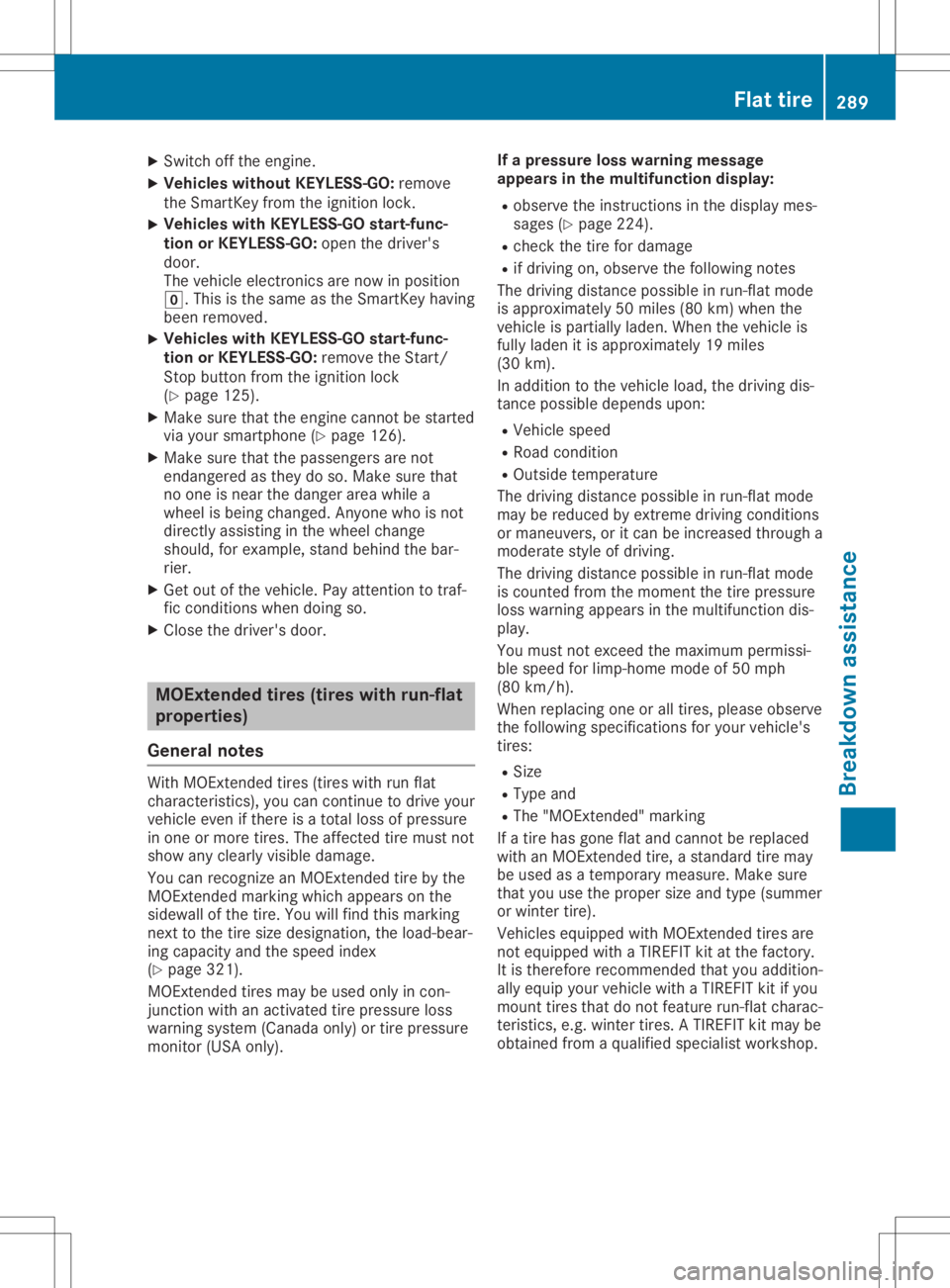
X
Swi tch offthe engi ne.
X Vehi cles without KEYLES S-GO :remo ve
the Smar tKeyfrom theigniti onlock.
X Vehi
cles with KEYLES S-GO start-fun c-
tio nor KEYLES S-GO :ope nthe driver' s
doo r.
The vehicleelectro nicsarenow inpos ition
005A. Thisis the same asthe Smar tKeyhaving
bee nremo ved.
X Vehi
cles with KEYLES S-GO start-fun c-
tio nor KEYLES S-GO :remo vethe Start/
Stop button from theigniti onlock
(Y page 125 ).
X Ma kesure that theengi necanno tbe star ted
via your sma rtpho ne(Ypage 126 ).
X Ma kesure that thepasse nger sare not
enda ngeredasthey doso. Makesure that
no one isnea rthe danger areawh ile a
wh eel isbei ng cha nged .Anyo newhois not
di rectl yas sis ting inthe wheel change
sho uld, for exa mpl e,stand behindthe bar-
rie r.
X Ge tou tof the vehicle. Pa yattenti ontotraf-
fic condi tions when doing so.
X Close thedriver' sdoo r. MOE
xtendedtires(ti res with run-fl at
prope rties)
Gen eral notes Wi
th MOExtend edtire s(ti res with run flat
cha racte ristics) ,yo ucan continu eto drive your
veh icleeve nif there isatotal loss ofpre ssu re
in one ormore tires.The affected tiremus tnot
sho wany clearlyvis ible da mag e.
You canreco gnize anMOExtend edtire bythe
MOExtend edmar king which appea rson the
sid ewallof the tire.You willfind thismarking
next tothe tire size designati on,the load -bea r-
ing capacityand thespeedindex
(Y page 321 ).
MOExtend edtire smay beused only incon-
juncti onwith an acti vate dtire pressu reloss
wa rning system (Cana daonly )or tire pressu re
moni tor(USA only). If
apres sure loss warn ingmess age
appears inthe multi functiondis play :
R obs erve theinstru ctions inthe displ aymes -
sa ges (Ypage 224 ).
R check thetire fordamag e
R ifdri ving on,observe thefollowi ng notes
The driving distance possiblein run-fl atmod e
is ap pro xima tely50miles(80 km)wh en the
veh icleis pa rtia lly la den. Whenthe vehicleis
ful lyladen itis ap pro xima tely19miles
(30 km).
In addition tothe vehicleload ,the driving dis-
tance possibledep ends upon:
R Veh iclespe ed
R Ro ad condi tion
R Ou tsid etemp erature
The driving distance possiblein run-fl atmod e
may bered uce dby extrem edri ving condi tions
or mane uvers,oritcan beincre ased throu gha
mod eratesty leof dri ving .
The driving distance possiblein run-fl atmod e
is cou nted from themome ntthe tire pressu re
lo ss wa rning appea rsinthe multifunction dis-
pl ay .
You mustnot excee dthe maxi mum permis si-
bl e spe edfor limp-h omemodeof 50 mph
(80 km/h ).
Whe nrep lacing oneoralltire s,plea se obs erve
the followi ng spe cificati ons foryour veh icle's
tire s:
R Size
R Type and
R The "MOExtend ed"marking
If atire hasgone flatand canno tbe rep laced
wi th an MOExtend edtire ,a stand ardtire may
be used asatemp orarymea sure. Makesure
that youus ethe proper size andtype(su mmer
or winter tire).
Veh icles equ ipped with MOExtend edtire sare
not equipped with aTIR EFIT kitatthe facto ry.
It is there forerecommend edthat youad dition-
al ly equ ipyour veh iclewi th aTIR EFIT kitifyo u
mou nttire sthat donot feature run-fl atcha rac-
teri stics ,e.g. winter tires.ATIR EFIT kitmay be
obta inedfrom aqu alifi ed spe cialist wo rksho p. Fl
at tire
289Breakdo wnassistanc e
Page 303 of 346
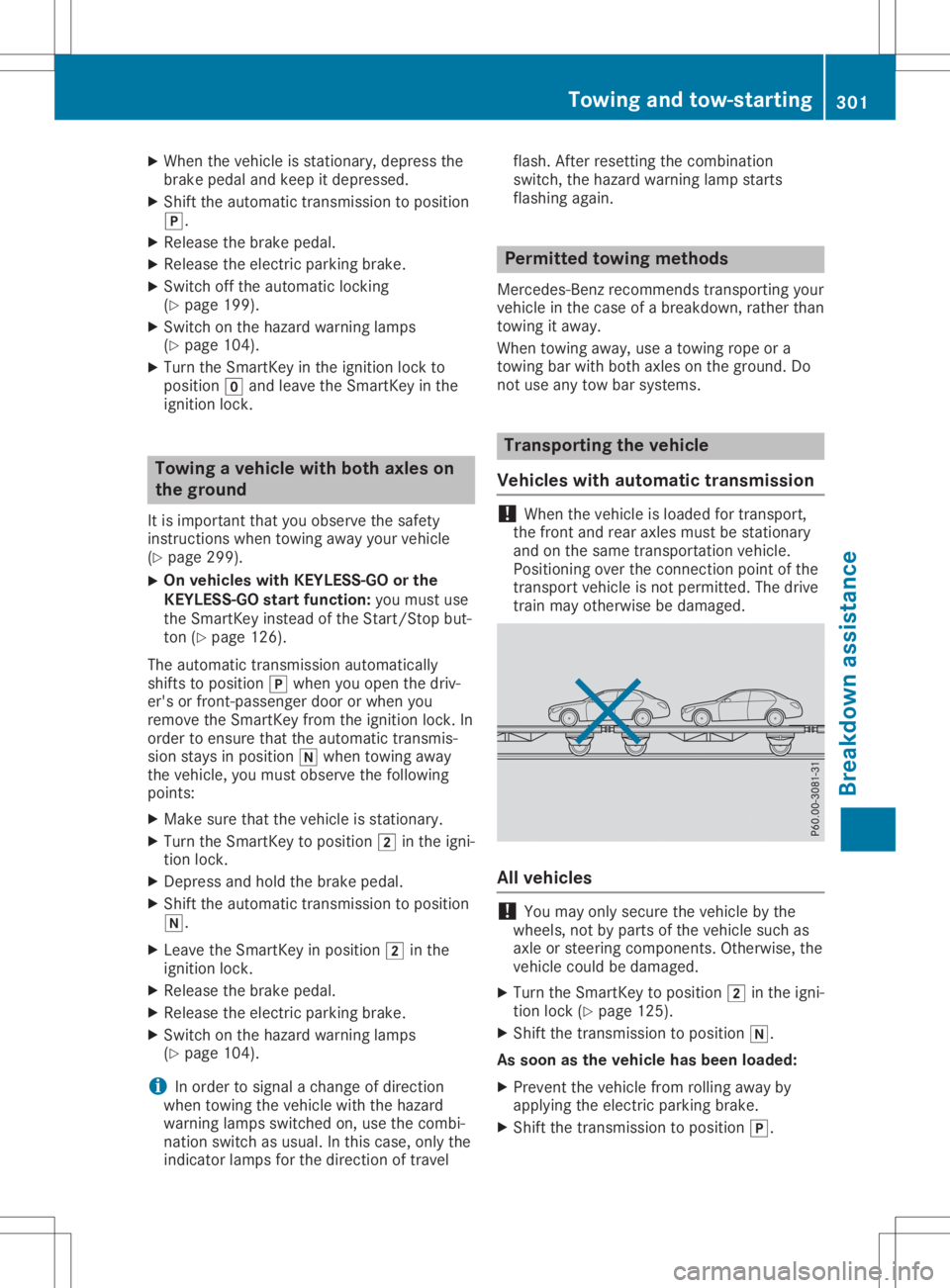
X
When thevehicle isstation ary,depress the
brake pedalandkeep itdepressed.
X Shift theautomatic transmission toposition
005D.
X Release thebrake pedal.
X Release theelectr icparking brake.
X Switc hoff the automatic locking
(Y page 199).
X Switc hon the hazard warning lamps
(Y page 104).
X Turn theSmart Keyinthe ignition lockto
position 005Aand leave theSmart Keyinthe
ignition lock. Towing
avehicle withboth axles on
the ground
It is importan tthat youobserve thesafety
inst ruction swhen towing awayyourvehicle
(Y page 299).
X On
vehicles withKEYLE SS-GO orthe
KEYLE SS-GO startfunction: youmust use
the Smart Keyinstead ofthe Start/S topbut-
ton (Ypage 126).
The automatic transmission automatically
shifts toposition 005Dwhen youopen thedriv-
er's orfron t-passenger doororwhen you
remove theSmart Keyfrom theignition lock.In
order toensure thattheautomatic transmis-
sion stays inposition 005Cwhen towing away
the vehicle, youmust observe thefollowing
points :
X Make surethatthevehicle isstation ary.
X Turn theSmart Keytoposition 0048inthe igni-
tion lock.
X Depress andhold thebrake pedal.
X Shift theautomatic transmission toposition
005C.
X Leave theSmart Keyinposition 0048inthe
ignition lock.
X Release thebrake pedal.
X Release theelectr icparking brake.
X Switc hon the hazard warning lamps
(Y page 104).
i In
order tosignal achange ofdirect ion
when towing thevehicle withthehazard
warning lampsswitched on,use thecombi-
nation switch asusual. Inthis case, onlythe
indicator lampsforthe direct ionoftravel flash.
Afterresett ingthe combin ation
switch, thehazard warning lampstarts
flashing again. Perm
ittedtowing methods
Mercedes- Benzrecomm endstransportin gyour
vehicle inthe case ofabreakdown, ratherthan
towing itaway.
When towing away,useatowing ropeora
towing barwith both axles onthe ground. Do
not use anytow barsystems. Tr
anspor tingthevehicle
Vehicles withautomat ictransmission !
When
thevehicle isloaded fortran sport,
the fron tand rear axles mustbestation ary
and onthe same transportat ionvehicle.
Position ingover theconn ection pointofthe
tran sport vehicle isnot permitt ed.The drive
train mayotherwise bedamaged. All
vehicles !
You
may onlysecure thevehicle bythe
wheels, notbyparts ofthe vehicle suchas
axle orsteerin gcompon ents.Other wise, the
vehicle couldbedamaged.
X Turn theSmart Keytoposition 0048inthe igni-
tion lock (Ypage 125).
X Shift thetran smission toposition 005C.
As soon asthe vehicle hasbeen loaded:
X Preven tthe vehicle fromrolling awayby
applying theelectr icparking brake.
X Shift thetran smission toposition 005D. Towing
andtow-sta rting
301Breakdown assistance Z
Page 309 of 346
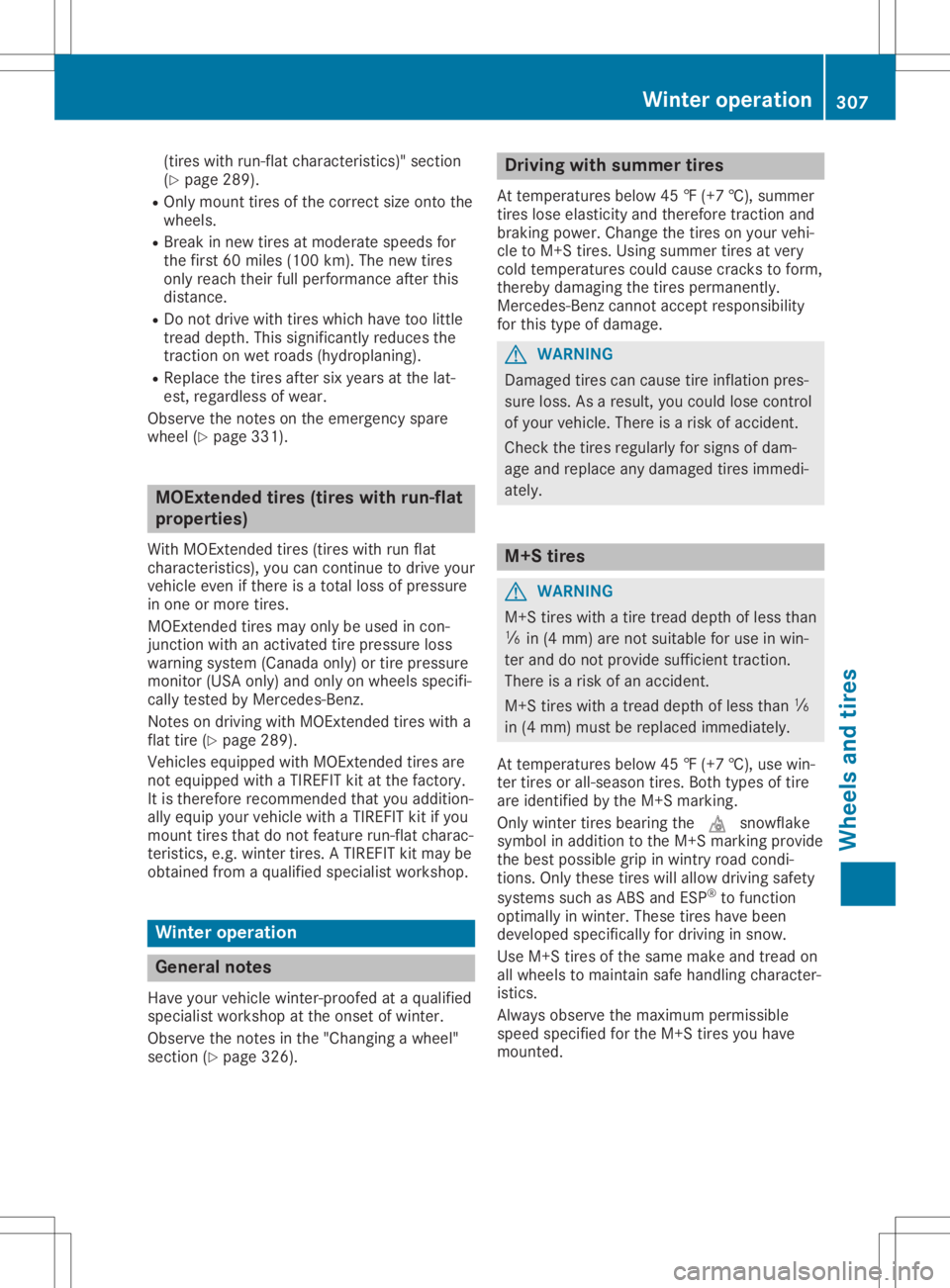
(tire
swith run-flatcharac teristic s)"sect ion
(Y page 289).
R Only mount tiresof the corr ectsize ontothe
wheels.
R Break innew tiresat moderat espeeds for
the first 60miles (100 km). Thenew tires
only reach theirfullperfor manceafter this
distan ce.
R Do not drive withtireswhich havetoolittle
tre ad depth. Thissignif icantlyreduces the
trac tion onwet roads (hydroplanin g).
R Replace thetiresafter sixyears atthe lat-
est, regardles sof wear.
Observ ethe noteson the emerge ncyspare
wheel (Ypage 331). MOExt
ended tires (tir eswith run-fla t
pr opert ies)
With MOExtended tires(tire swith runflat
charac teristic s),you can continue todrive your
vehic leeven ifther eis atot alloss ofpressur e
in one ormore tires.
MOE xtended tiresmay onlybeused incon -
jun ction with anact ivated tirepressur eloss
warnin gsystem (Canada only)ortire pressur e
mon itor(USA only)andonly onwheels specifi-
cally testedbyMerc edes-B enz.
Not eson drivin gwith MOExtended tireswith a
flat tire (Ypage 289).
Vehicles equipped withMOExtended tiresare
not equipped withaTIREF ITkit atthe factory.
It is ther efore recommen dedthat youaddition -
ally equip yourvehic lewith aTIREF ITkit ifyou
mount tiresthat donot featur erun- flatcharac -
ter istic s,e.g. wintertire s.ATIREF ITkit may be
obtain edfrom aqualified specialist workshop. Wint
eropera tion Genera
lnotes
Have yourvehic lewint er-proof edataqualified
specialist workshopatthe onset ofwint er.
Observ ethe notesinthe "Changing awheel"
sect ion(Ypage 326). Driving
withsummer tires
At tem peratur esbelow 45‡(+7†), summer
tire slose elastic ityand therefore traction and
brakin gpower. Change thetireson your vehi-
cle toM+S tires.Using summer tiresat very
cold temperatur escould cause crackstoform ,
ther eby damaging thetiresperman ently.
Merc edes-B enzcann otaccept responsibility
for this type ofdamage. G
WARN
ING
Damaged tirescan cause tireinflat ionpres-
sure loss. Asaresult ,you could losecontrol
of your vehic le.There isarisk ofacciden t.
Check thetiresregularly forsigns ofdam-
age and replace anydamaged tiresimmedi-
ately. M+S
tires G
WARN
ING
M+S tireswith atire tread depth ofless than
00CF in(4 mm) arenot suitable foruse inwin-
ter and donot provide sufficienttraction.
There isarisk ofan acciden t.
M+S tireswith atre ad depth ofless than 00CF
in (4 mm) must bereplaced immediat ely.
At tem peratur esbelow 45‡(+7 †), use win-
ter tiresor all-season tires.Bot htypes oftire
are ident ifiedbythe M+S marking.
Only wintertire sbearing the004D snowf lake
symbol inaddition tothe M+S markingprovide
the best possible gripinwint ryroad condi-
tion s.Only thesetire swill allow drivingsafet y
system ssuch asABSand ESP®
to func tion
optim allyinwint er.These tireshave been
developed specificallyfordrivin gin snow.
Use M+S tiresof the same make andtread on
all wheels tomaint ainsafe handlin gcharac ter-
istic s.
Always observethe maxim umpermiss ible
speed specifiedforthe M+S tiresyou have
mount ed. Wint
eropera tion
307Wheels andtires Z
Page 310 of 346
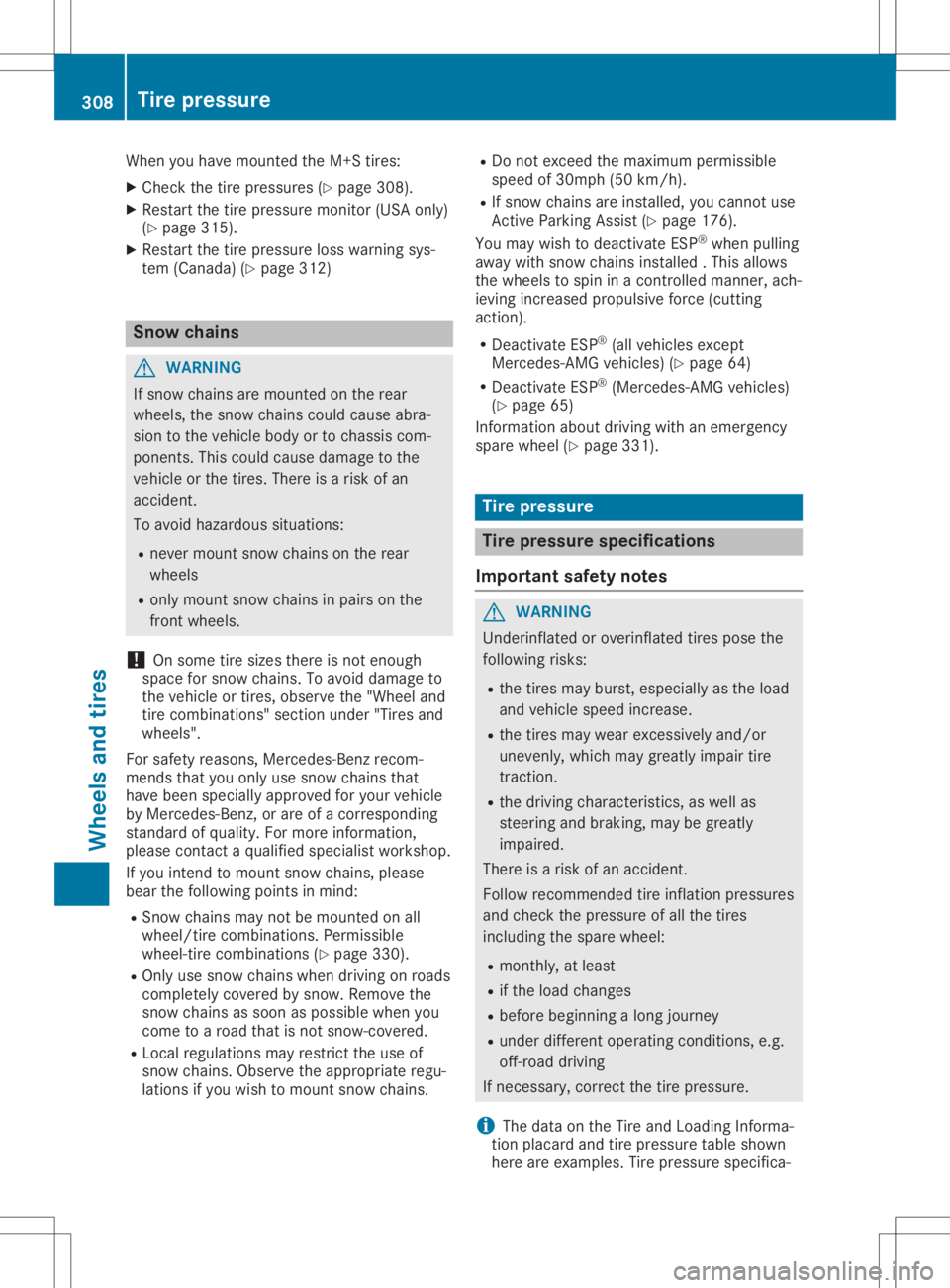
When
youhave mount edthe M+S tires:
X Check thetire pressures (Ypage 308).
X Restart thetire pressure monitor(USA only)
(Y page 315).
X Restart thetire pressure losswarning sys-
tem (Canada) (Ypage 312) Snow
chains G
WARNIN
G
If snow chains aremount edon the rear
wheels, thesnow chains couldcause abra-
sion tothe vehicle bodyortochassis com-
ponen ts.This could cause damage tothe
vehicle orthe tires. There isarisk ofan
accident .
To avoid hazardous situations:
R never mount snowchains onthe rear
wheels
R only mount snowchains inpairs onthe
fron twheels.
! On
some tiresizes there isnot enough
space forsnow chains. Toavoid damage to
the vehicle ortires, observe the"Wheel and
tire combin ations" sectionunder "Tiresand
wheels".
For safety reasons, Mercedes- Benzrecom-
mends thatyouonly usesnow chains that
have been specially approved foryour vehicle
by Mercedes- Benz,or are ofacorr esponding
standard ofquality. Formore inform ation,
please contactaqualified specialist workshop.
If you inten dto mount snowchains, please
bear thefollowing pointsinmind:
R Sno wchains maynotbemount edon all
wheel/tire combinations.Permissible
wheel-tire combinations(Ypage 330).
R Only usesnow chains whendriving onroads
complet elycovered bysnow. Remove the
snow chains assoon aspossible whenyou
come toaroad thatisnot snow-c overed.
R Local regulations mayrestrictthe use of
snow chains. Observe theappropriate regu-
lations ifyou wish tomount snowchains. R
Do not exceed themaximum permissible
speed of30mph (50km/ h).
R Ifsnow chains areinstalled, youcann otuse
Act ive Parking Assist(Ypage 176).
You may wish todeactivat eES P®
when pulling
away withsnow chains installed .This allows
the wheels tospin inacont rolled manner,ach-
ieving increased propulsive force(cutt ing
action ).
R Deact ivateESP®
(all vehicles except
Mercedes- AMGvehicles) (Ypage 64)
R Deact ivateESP®
(Mercedes- AMGvehicles)
(Y page 65)
Inf ormation aboutdriving withanemergen cy
spare wheel (Ypage 331). Tir
epr essure Tir
epr essure specifications
Impor tantsafety notes G
WARNIN
G
Underin flatedoroverinf latedtirespose the
following risks:
R the tires mayburst, especially asthe load
and vehicle speedincrease.
R the tires maywear exces sively and/or
unevenly, whichmaygreatly impairtire
trac tion.
R the driving charact eristics,as well as
steerin gand braking, maybegreatly
impaired.
There isarisk ofan accident .
Follow recomm endedtireinflation pressures
and check thepressure ofall the tires
including thespare wheel:
R mont hly,atleast
R ifthe load changes
R before beginnin galong journ ey
R under differen toperating conditions,e.g.
off- road driving
If neces sary,correctthe tire pressure.
i The
data onthe Tire andLoading Informa-
tion placard andtirepressure tableshown
here areexamples. Tirepressure specifica- 308
Tir
epr essureWheels andtires
Page 312 of 346
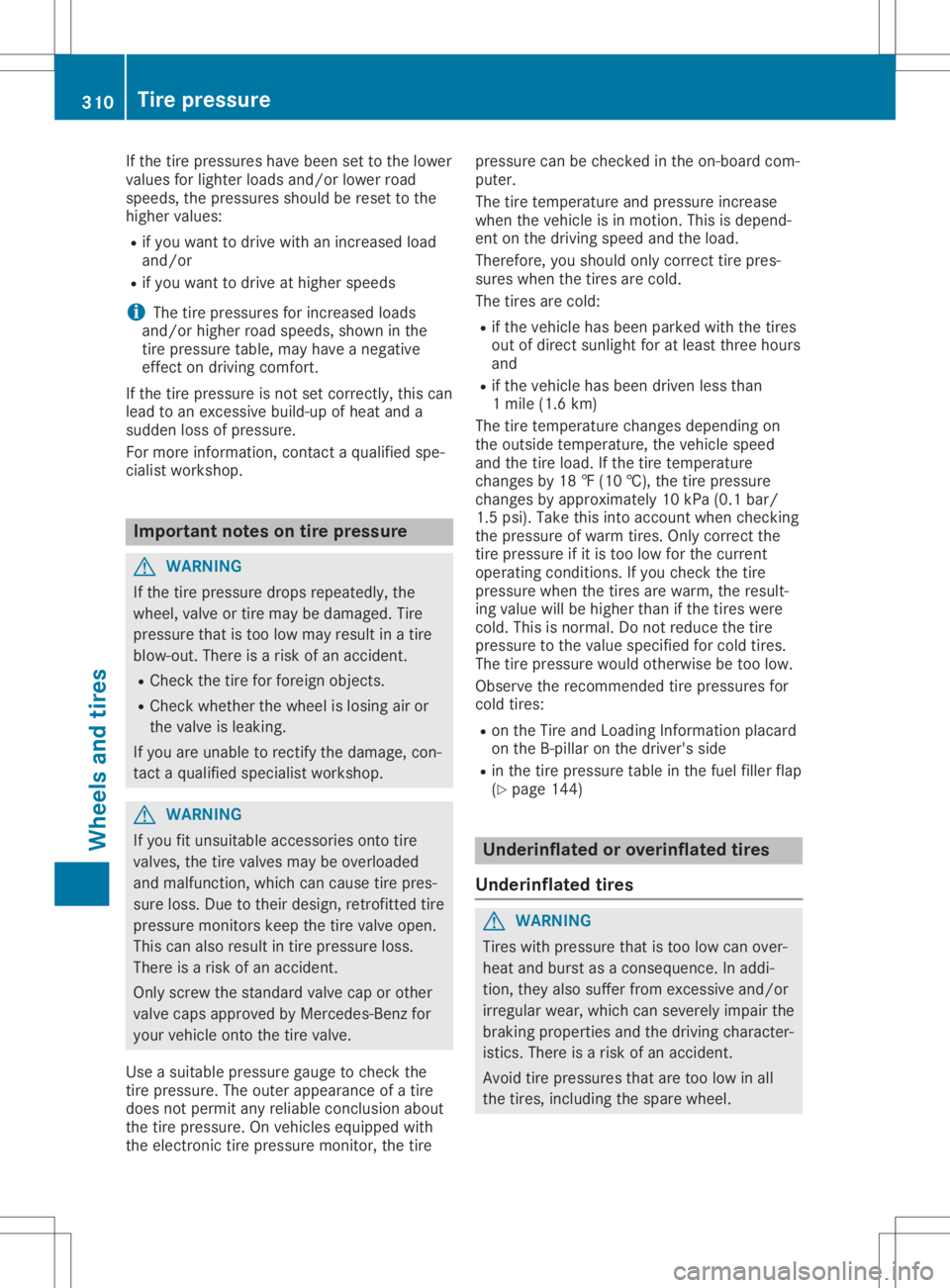
If
the tire pressu reshave been settothe lowe r
valu esfor lighter loadsand/or lowerroad
speed s,the pressu resshoul dbe reset tothe
higher values:
R ifyou want todrive withanincreased load
and/or
R ifyou want todrive athigher speeds
i The
tirepressu resforincreased loads
and/or higherroadspeed s,shown inthe
tire pressu retable, mayhave anegative
effect ondriving comfort.
If the tire pressu reisnot setcorrectly, thiscan
lea dto an excessive build-up ofheat anda
sudd enloss ofpressu re.
For more information, contactaqua lifiedspe-
ciali stworkshop. Important
notesontire pressure G
WARNING
If the tire pressu redrops repeatedly,the
wheel ,valve ortire may bedama ged.Tire
pressu rethat istoo low may resul tin atire
blow -out. There isarisk ofan accident.
R Check thetire forforeign objects.
R Check whether thewheel islosing airor
the valve islea king.
If you areunabl eto rectify thedama ge,con-
tact aqua lifiedspecia listworkshop. G
WARNING
If you fitunsui table accessorie sonto tire
valves ,the tire valves maybeoverloa ded
and malfu nction, whichcancause tirepres-
sure loss. Duetotheir desig n,retrofitted tire
pressu remonitors keepthetire valve open.
This canalso resul tin tire pressu reloss.
There isarisk ofan accident.
Only screw thestandard valvecaporother
valve capsappro vedbyMercedes-Benz for
you rvehicle ontothetire valve.
Use asuita blepressu regau getocheck the
tire pressu re.The outer appearance ofatire
does notpermit anyrelia bleconclusion about
the tire pressu re.On vehicle sequi pped with
the electronic tirepressu remonitor, thetire pressu
recan bechecked inthe on-board com-
puter.
The tiretemperature andpressu reincrease
when thevehicle isin motion. Thisisdepend-
ent onthe driving speedandtheload .
Therefore, youshoul donly correct tirepres-
sures whenthetires arecold.
The tires arecold:
R ifthe vehicle hasbeen parked withthetires
out ofdirect sunlightfor atlea stthree hours
and
R ifthe vehicle hasbeen driven lessthan
1 mile (1.6km)
The tiretemperature changesdependingon
the outsid etemperature ,the vehicle speed
and thetire load .If the tire temperature
changes by18 ‡(10 †), thetire pressu re
changes byappro ximately 10kPa (0.1 bar/
1.5 psi).Take thisinto account whenchecking
the pressu reofwarm tires.Onlycorrect the
tire pressu reifit is too low forthe current
opera tingconditions. Ifyou check thetire
pressu rewhen thetires arewarm, theresul t-
ing valu ewil lbe highe rthan ifthe tires were
cold. Thisisnormal. Donot reduce thetire
pressu reto the valu especifie dfor cold tires.
The tirepressu rewou ldotherwise betoo low.
Observe therecommended tirepressu resfor
cold tires:
R on the Tire andLoadi ngInformation placard
on the B-pilla ron the driver's side
R in the tire pressu retable inthe fuel fillerflap
(Y page 144) Underinfl
atedoroverin flated tires
Underinfl atedtires G
WARNING
Tires withpressu rethat istoo low can over-
heat andburst asaconsequence. Inaddi -
tion, theyalsosuffer fromexcessive and/or
irregu larwea r,which canseverel yimpa irthe
braking propertie sand thedriving character-
istics. Thereisarisk ofan accident.
Avoid tirepressu resthat aretoo low inall
the tires, includi ngthe spare wheel. 310
Tire
pressureWheel sand tires
Page 314 of 346

rotation
ofawhee lchanges asaresul tof a
loss ofpressu re,acorrespo ndingwarning
messa gewillapp ear inthe multi function dis-
pla y.
You canrecognize thetire pressu reloss warn-
ing bythe Run Flat Indicato rActive Run
Flat Indicato rActive
Press 'OK'toRestart Press
'OK'toRestart messageinthe mul-
tifunction displayinthe Serv. Serv.
menu. Informa-
tion onthe messa gedisp laycan befound in
the "Restarting thetire pressu reloss warni ng"
section (Ypag e312) .
Important safetynotes The
tirepressu rewarni ngsystem doesnot
warn youofan incorrectly settire pressu re.
Observe thenotes onthe recommended tire
pressu re(Y pag e308) .
The tirepressu reloss warni ngdoes not
repla cethe need toregu larlycheck thetire
pressu re.Aneven lossofpressu reon severa l
tires atthe same timecannot bedetected by
the tire pressu reloss warni ngsystem.
The tirepressu remonitor isnot ableto warn
you ofasudd enloss ofpressu re,e.g. ifthe
tire ispenetrated byaforeig nobject. Inthe
event ofasudd enloss ofpressu re,bring the
vehicl eto ahal tby braking carefully.Avoid
abru ptsteering movements.
The function ofthe tire pressu reloss warni ng
system islimi ted ordela yedif:
R snow chains aremounted onyou rvehicl e's
tires.
R road conditions arewintry.
R you aredrivi ngon sand orgravel .
R you adoptavery sporty drivingstyle (corner-
ing athigh speedsordrivi ngwith high rates
of accele ration).
R you aredrivi ngwith aheavy load(in the
vehicl eor on the roof)
Restarting thetire pressure losswarn-
ing system Resta
rtthe tire pressu reloss warni ngsystem
if you have:
R changed thetire pressu re
R changed thewhee lsor tires
R mounted newwhee lsor tires
X Before restarting, makesurethatthetire
pressu resare setprope rlyon allfour tires
for the respe ctiveopera tingconditions. The
recommended tirepressu recan be
found onthe Tire andLoad ingInformation
pla card onthe B-pill ar.Additio nally,atire
pressu retable isattached tothe fuel filler
flap .The tirepressu reloss warni ngsystem
can only givereliablewarni ngsifyou have
set the correct tirepressu re.Ifan incorrect
tire pressu reisset, these incorrect values
wil lbe monitored.
X Also observe thenotes inthe section ontire
pressu res(Ypag e308) .
X Make surethattheSmartKey isin posi tion
0048 inthe ignitio nlock (Ypag e125).
X Press 0059or0065 onthe steering wheel
to sele ctthe Serv. Serv.
menu.
X Press the0063 or0064 button tosele ct
Tire Pressure Tire
Pressure .
X Press the0076 button.
The Run Flat Indicato rActive Press Run
Flat Indicato rActive Press
'OK' toRestart 'OK'
toRestart messageapp ears inthe
multi function display.
If you wishto con firm therestart:
X Press the0076 button.
The Tire Pressure NowOK? Tire
Pressure NowOK?messa ge
app ears inthe multi function display.
X Press the0063 or0064 button tosele ct
Yes Yes.
X Press the0076 button.
The Run Flat Indicato rRestarte d Run
Flat Indicato rRestarte dmes-
sage appears inthe multi function display.
After ateach-in period,the tire pressu re
loss warni ngsystem willmonitor thesettire
pressu resofall four tires.
If you wishto canc elthe restart:
X Press the0038 button.
or
X Ifthe Tire Pressure NowOK? Tire
Pressure NowOK?messa ge
app ears, press the0063 or0064 button to
sele ctCancel Cancel.
X Press the0076 button.
The tirepressu revalu esstored atthe last
restart willcontinue tobe monitored. Tire
pressure monitor(Can adaonly)
Gene ralnotes If
atire pressu remonitor isinstall ed,the vehi-
cle's whee lshave sensors thatmonitor thetire
pressu resinall four tires. Thetirepressu re 312
Tire
pressureWhee lsand tires
Page 317 of 346
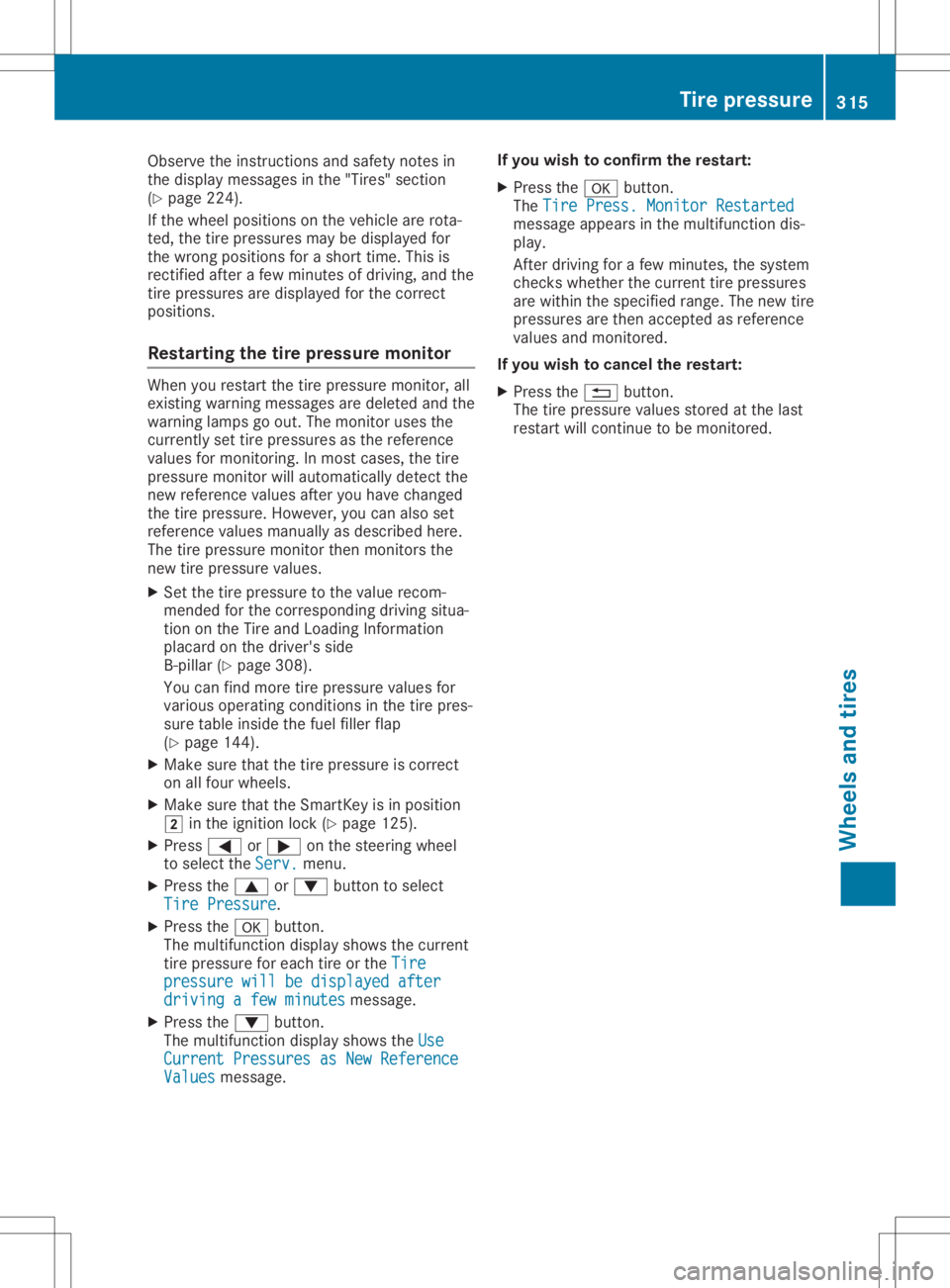
Observe
theinstruct ionsandsafety notesin
the displa ymessages inthe "Tires" section
(Y page 224).
If the wheel positions onthe vehicle arerota-
ted, thetire pressures maybedispla yedfor
the wrong positions forashort time.Thisis
rectified afterafew minutes ofdriving, andthe
tire pressures aredispla yedforthe correct
positions.
Restart ingthe tire pressure monitor When
yourestart thetire pressure monitor,all
existing warning messages aredeleted andthe
warning lampsgoout. Themonitor usesthe
currently settire pressures asthe reference
value sfor monitoring. Inmost cases, thetire
pressure monitorwillautomaticall ydetect the
new reference valuesafter youhave changed
the tire pressure. However, youcan also set
reference valuesmanuall yas described here.
The tirepressure monitorthenmonitors the
new tirepressure values.
X Set thetire pressure tothe value recom-
mended forthe corresponding drivingsitua-
tion onthe Tire andLoading Information
placard onthe driver's side
B-pillar (Ypage 308).
You canfind more tirepressure valuesfor
various operating conditions inthe tire pres-
sure table inside thefuel filler flap
(Y page 144).
X Make surethatthetire pressure iscorrect
on allfour wheels.
X Make surethattheSmartKey isin position
0048 inthe ignition lock(Ypage 125).
X Press 0059or0065 onthe steering wheel
to select theServ. Serv.
menu.
X Press the0063 or0064 button toselect
Tire Pressure Tire
Pressure.
X Press the0076 button.
The multifunction displayshows thecurrent
tire pressure foreach tireorthe Tire Tire
pressure willbedisplayed after pressure
willbedisplayed after
driving afew minutes driving
afew minutes message.
X Press the0064 button.
The multifunction displayshows theUse Use
Current Pressures asNew Reference Current
Pressures asNew Reference
Values Values
message. If
you wish toconfirm therestart :
X Press the0076 button.
The Tire Press. Monitor Restarted Tire
Press. Monitor Restarted
message appearsinthe multifunction dis-
play .
After driving forafew minutes, thesystem
checks whether thecurrent tirepressures
are within thespecified range.Thenew tire
pressures arethen accepted asreference
value sand monitored.
If you wish tocance lthe restart :
X Press the0038 button.
The tirepressure valuesstored atthe last
restart willcont inue tobe monitored. Tire
pressur e
315Wheels andtires Z
Page 329 of 346
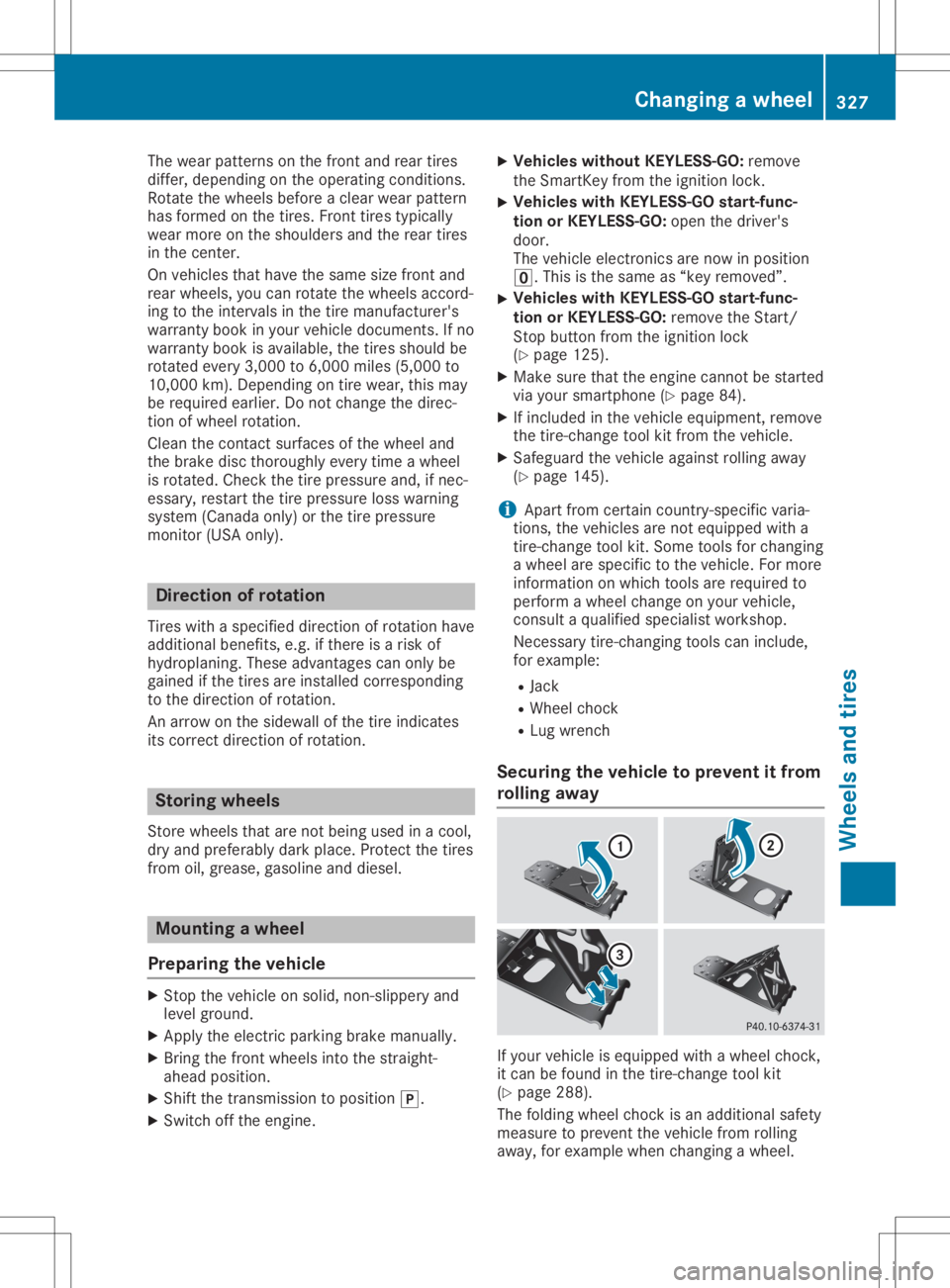
The
wear pattern son the front andrear tires
differ, depending onthe operating conditions.
Rotate thewheels beforeaclear wearpattern
has formed onthe tires. Fronttires typically
wear more onthe shoulders andtherear tires
in the cent er.
On vehicles thathave thesame sizefront and
rear wheels, youcan rotat ethe wheels accord-
ing tothe inter valsinthe tire manufact urer's
warranty bookinyour vehicle document s.Ifno
warranty bookisavailabl e,the tires should be
rotat edevery 3,000 to6,000 miles(5,000 to
10,00 0km). Dependin gon tire wear, thismay
be required earlier.Donot change thedirec-
tion ofwheel rotation.
Clean thecont actsurfaces ofthe wheel and
the brake discthoroughly everytimeawheel
is rotat ed.Check thetire pressure and,ifnec-
essary, restartthetire pressure losswarning
system (Canada only)orthe tire pressure
monit or(USA only). Direction
ofrota tion
Tires withaspecified directionofrotat ionhave
additional benefits,e.g. ifthere isarisk of
hydroplaning. Theseadvantages canonly be
gained ifthe tires areinstalled correspon ding
to the direction ofrotat ion.
An arrow onthe sidewall ofthe tire indicates
its correc tdirection ofrotat ion. Storing
wheels
Stor ewheels thatarenot being usedinacool,
dry and preferably darkplace. Protectthe tires
from oil,grease, gasoline anddiesel. Mounting
awheel
Prepa ringthevehicle X
Stop thevehicle onsolid, non-slippery and
level ground.
X Apply theelectric parking brakemanually.
X Bring thefront wheels intothestraight-
ahead position.
X Shift thetrans mission toposition 005D.
X Switch offthe engine. X
Vehicles withoutKEYLESS-GO: remove
the Smart Keyfrom theignition lock.
X Vehicles
withKEYL ESS-GO start-func-
tion orKEYL ESS-GO: openthedriver's
door.
The vehicle electron icsare now inposition
0092. This isthe same as“key removed”.
X Vehicles
withKEYL ESS-GO start-func-
tion orKEYL ESS-GO: removetheStart /
Stop button fromtheignition lock
(Y page 125).
X Make surethattheengine cannotbe start ed
via your smartphon e(Y page 84).
X Ifincluded inthe vehicle equipment, remove
the tire- change toolkitfrom thevehicle.
X Safeguard thevehicle against rollingaway
(Y page 145).
i Apart
fromcertaincount ry-specific varia-
tions, thevehicles arenot equipped witha
tire- change toolkit.Some toolsforchanging
a wheel arespecific tothe vehicle. Formore
inform ationonwhich toolsarerequired to
perform awheel change onyour vehicle,
consult aqualified specialist workshop.
Necessary tire-changing toolscaninclude,
for example:
R Jack
R Wheel chock
R Lug wrench
Securing thevehicle toprevent itfrom
rolling away If
your vehicle isequipped withawheel chock,
it can befound inthe tire- change toolkit
(Y page 288).
The folding wheelchock isan additional safety
measure toprevent thevehicle fromrolling
away ,for example whenchanging awheel. Changing
awheel
327Wheels andtires Z